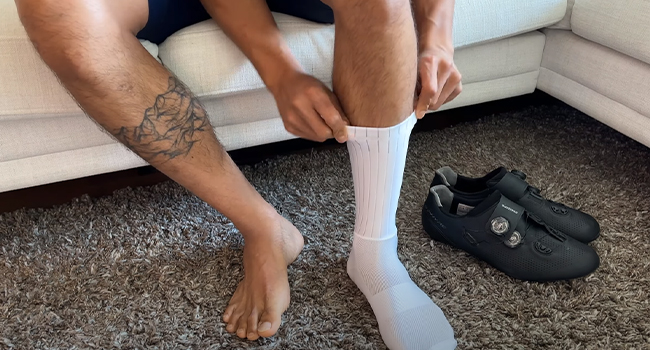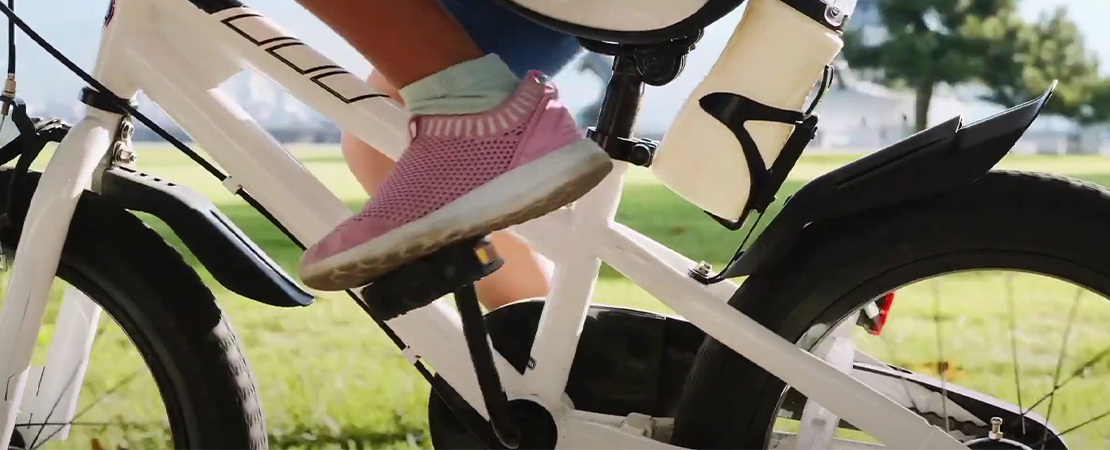Ill-fitting cycling shoes are the most frequent cause of hot spots when we ride. When our foot are compressed, especially in the forefoot, the interdigital nerves fire up and send signals of burning and numbness to our brains (often simultaneously with the incredible power of our nervous system).
But really, the treatment and prevention of ‘hot foot’ comes down to your cycling equipment. Trying wider shoes with a roomier front end will prevent squashing your toes together and pinching the nerves between them. Loosening straps (even taking them off at café stops) may contribute to the solution.
We will examine different strategies and tools you can use to prevent hot foot and enjoy a more comfortable cycling experience.
How to Prevent Hot Foot When Cycling: 6 Strategies

Hot foot is a common condition caused by pressure on the ball of the foot during cycling, which can lead to pain, numbness, and discomfort. Many strategies can help prevent hot foot and keep your foot cool and comfortable during your rides.
Selecting the Perfect Shoes
Regardless of how long your cycling journey is, proper footwear is essential. The wrong shoes can cause various foot problems, including hotfoot. Here are some factors to consider when selecting the perfect shoes to prevent hot foot:
- Breathability: Choose shoes made of a breathable material to prevent your foot from overheating.
- Sole Stiffness: A shoe with a stiff sole provides better power transfer while cycling but can lead to hot foot. Consider a more flexible sole if a hot foot is a persistent issue.
- Size: Ensure your shoes fit correctly to avoid pinching and pressure points.
- Cleat Positioning: Placing your cleats can also contribute to hot foot. Experiment with different positions until you find a placement that works best for you.
Technology to Consider When Choosing Cycling Shoes
Technology has come a long way in cycling shoes, and it’s vital to understand how it can prevent hot foot. Here are some features to look for when selecting a pair of cycling shoes:
- Ventilation: Shoes with mesh panels or perforations provide excellent airflow to prevent overheating.
- Specific Cushioning: Footbeds or insoles with specific cushioning, such as gel or foam, can help reduce foot pressure and alleviate hot foot.
- Custom Orthotics: Customized orthotics designed explicitly for cycling shoes can also help relieve pressure and offer tailored support.
- Cleat Compatibility: Ensure your shoes are compatible with your cleats to ensure an ideal fit.
Achieving Relief
Relieving foot pressure on the ball, or the metatarsals, is crucial in preventing hot foot. Here are some tips to achieve relief:
- Custom Orthotics: As mentioned earlier, customized orthotics can help relieve pressure on specific foot areas, including the metatarsals.
- Metatarsal Pads: Metatarsal pads are specially designed pads that adhere inside your shoe and offer extra support and cushioning to the ball of your foot.
- Stretches: Simple stretches, such as toe scrunches or calf stretches, can loosen the muscles around the ball of your foot, providing relief.
Optimizing Cleat Placement
Cleat positioning is crucial to preventing hotfoot. Here are some things to consider when optimizing your cleat placement:
- Forefoot Cleat Placement: Positioning your cleat closer to your toes can help alleviate ball of foot pressure.
- Midfoot Cleat Placement: Moving your cleat backward or towards the midfoot can also distribute pressure more evenly and reduce hot foot.
- Seek Professional Help: Consider seeking professional bike fitting services to help you determine the optimal cleat placement for your cycling needs.
Sock and Sole Solutions

Choosing the right socks and sole stiffness is also essential in preventing hot foot. Keep the following in mind:
- Sole Stiffness vs. Comfort: A stiffer sole provides better power transfer, but a more flexible sole reduces pressure on the foot. Find the right balance for your needs.
- Breathable Socks: Choose socks made of moisture-wicking materials that promote ventilation and prevent overheating.
Strategies for On-The-Ride Relief:
The hot foot can still occur even with best footwear, cleat placement, and sock choices. Here are some on-the-ride relief strategies:
- Adjustments: Make minor adjustments to straps and buckles throughout your ride to distribute pressure more evenly and alleviate hot foot.
- Breaks: Taking short breaks to stretch and massage your foot can help improve circulation, reduce pressure, and alleviate hot foot.
- Proper Hydration and Nutrition: Staying properly hydrated and taking in the appropriate nutrients can help regulate body temperature and improve blood flow, reducing the likelihood of a hot foot.
Conclusion
Preventing hot foot is essential for any cyclist, no matter their experience level. By taking steps such as selecting the perfect shoes, relieving pressure on the metatarsals, optimizing cleat placement, and taking rest breaks when necessary, you can ensure that your cycling experience is as comfortable and enjoyable as possible.
Be sure to tailor your approach to your needs and preferences, and seek professional advice or guidance when necessary. You can ensure that hot foot is no longer a barrier to your enjoyment of cycling.
FAQs
What Causes My Foot to Burn When I Cycle?
When our foot are compressed, particularly in the forefoot area, the interdigital nerves activate, transmitting burning sensations and numbness to our brains. It’s remarkable how our nervous system can generate these signals simultaneously. After this has been triggered, it takes some time to subside after a ride.


